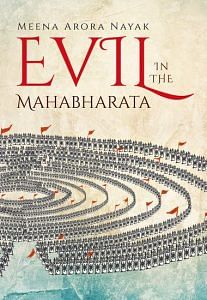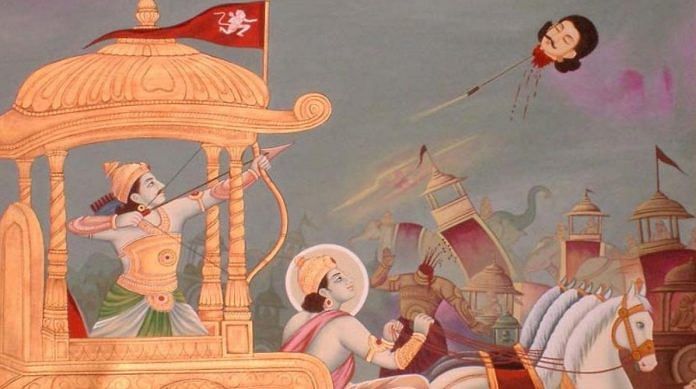US-based professor Meena Arora Nayak’s take on the epic seems to push an agenda. Readers ought to rather read the original text.
There is an excellent book that can be written on the notion of evil in the Mahabharata, but this is not it.
Professor Meena Arora Nayak is a professor of English in the United States and has written novels and children’s books. Those are excellent qualifications for writing such a book and it is based on a great deal of research – seemingly.
These are strong words. Let me substantiate by quoting the author herself, on the Nishadas and Ekalavya.
“Another example of this inequity is when ravenous Garuda is directed by his mother, Vinata, to satisfy his hunger by consuming all the people in the low caste Nishada tribe but never to slay any Brahmin.”
Elsewhere, “The clearest example of this is Eklavya, who belongs to the Nishada tribe [a sudra (sic)] but feels naturally inclined to be a warrior. He is not only rejected by Drona because of his caste, but he is also made to suffer the extreme consequence of aspiring to be a Kshatriya by cutting off and giving his right thumb to Drona, which deprives him of the ability to use a bow and arrow.”
When Professor Nayak quotes the Mahabharata, she uses Manmatha Nath Dutt’s translation. There are three unabridged translations of the Mahabharata in English, Dutt’s, Kishori Mohan Ganguli’s, and mine. Mine is based on the critical edition, and there are some differences between the critical edition and the texts used by Dutt and Ganguli.
Therefore, I won’t quote from mine. Both Dutt and Ganguli used the same Sanskrit text. Their language naturally differs, but not the content. I will quote from Ganguli, not Dutt, and there is a simple reason for this. Ganguli’s is available online and you can check the veracity of what I will quote. There is no legitimate online version of Dutt’s.
The following incident happens before Drona and the Pandavas meet Ekalavya. “Some time after, O bull of Bharata’s race, Drona, accompanied by all of his pupils, went to the bank of the Ganga to bathe in that sacred stream. And when Drona had plunged into the stream, a strong alligator, sent as it were, by Death himself, seized him by the thigh. And though himself quite capable, Drona in a seeming hurry asked his pupil to rescue him. And he said, ‘O, kill this monster and rescue me.’ Contemporaneously with this speech, Vibhatsu (Arjuna) struck the monster within the water with five sharp arrows irresistible in their course, while the other pupils stood confounded, each at his place. Beholding Arjuna’s readiness, Drona considered him to be the foremost of all his pupils, and became highly pleased.”
Pleased, Drona gave him a special weapon and promised, “The preceptor then, addressing him again, said, ‘None else in this world will ever become a superior bowman to thee. Vanquished thou shall never be by any foe, and thy achievements will be great.’” Note the pledge given by Drona.
“Thereafter, Drona began to teach Arjuna the art of fighting on horse-back, on the back of elephants, on car, and on the ground. And the mighty Drona also instructed Arjuna in fighting with the mace, the sword, the lance, the spear, and the dart. And he also instructed him in using many weapons and fighting with many men at the same time. And hearing reports of his skill, kings and princes, desirous of learning the science of arms, flocked to Drona by thousands. Amongst those that came there, O monarch, was a prince named Ekalavya, who was the son of Hiranyadhanus, king of the Nishadas.
“Drona, however, cognisant of all rules of morality, accepted not the prince as his pupil in archery, seeing that he was a Nishada who might excel all his high-born pupils. But, O oppressor of all enemies, the Nishada prince, touching Drona’s feet with bent head, wended his way into the forest, and there he made a clay-image of Drona, and began to worship it respectfully, as if it was his real preceptor, and practised weapons before it with the most rigid regularity. In consequence of his exceptional reverence for his preceptor and his devotion to his purpose, all the three processes of fixing arrows on the bowstring, aiming, and letting off became very easy for him.”
Note that Ekalavya was the son of Hiranyadhanu, the king of the Nishadas. Note that Hirnayadhanu was Jarasandha’s general and that he fought against the Yadavas when Jarasandha attacked them. Note that, later, Krishna killed Ekalavya. Note that Ekalavya’s son fought on the Kaurava side in the Kurukshetra war. In other words, Hiranyadhanu and Ekalavya were on the “wrong” side. In the given quote, note that Drona was concerned that Ekalavya would excel his other pupils. Note also that Drona was concerned with the rule of morality (dharma). We are told nothing more, certainly nothing about varna being an impediment.
Subsequently, they run into Ekalavya as a skilled archer. “Vaisampayana continued, The Pandavas then, having made themselves acquainted with everything connected with him, returned (to the city), and going unto Drona, told him of that wonderful feat of archery which they had witnessed in the woods. Arjuna, in particular, thinking all the while, O king, saw Drona in private and relying upon his preceptor’s affection for him, said, ‘Thou hadst lovingly told me, clasping me, to thy bosom, that no pupil of thine should be equal to me. Why then is there a pupil of thine, the mighty son of the Nishada king, superior to me?’”
At this, Dronacharaya asked for Ekalavya’s right thumb as dakshina. It was about the promise to Arjuna, not a word was said about Ekalavya being a Nishada. “After this, when the Nishada prince began once more to shoot with the help of his remaining fingers, he found, O king, that he had lost his former lightness of hand. And at this Arjuna became happy, the fever (of jealousy) having left him.”
Contrary to what the author thinks, Ekalavya had no desire to cross varnas and become a Kshatriya. He did want to learn archery and fight. Contrary to what the author thinks, Ekalavya did not lose his ability to use the bow and arrow. Contrary to what the author thinks, a Nishada is not a Shudra. (King Nala was also a Nishada.)
This still leaves Professor Nayak’s first quote, about what Vinata told Garuda. “Sauti said, ‘Garuda, thus addressed by the snakes, then said unto his mother, ‘I shall go to bring amrita, I desire to eat something in the way. Direct me to it.’ Vinata replied, ‘In a remote region in the midst of the ocean, the Nishadas have their fair home. Having eaten the thousands of Nishadas that live there, bring thou amrita. But let not thy heart be ever set on taking the life of a Brahmin. Of all creatures a Brahmin must not be slain.’”
While not killing a Brahmin is standard stuff, do you think the author’s quote accurately represents what Vinata said about Nishadas?
The book seems to be less about research and more about pushing a thesis and an agenda. Don’t bother to read it. Read the Mahabharata instead.

Excerpted from Evil in the Mahabharata, Oxford University Press, India, with due permission from the author, Meena Arora Nayak,







“While not killing a Brahmin is standard stuff, do you think the author’s quote accurately represents what Vinata said about Nishadas?”
You’ve picked only 2 sentences in the book, copy pasted entire sections of the story, and then glossed over non-killings of Brahmins to focus on your cherry picked second quote? Maybe the authour has a bias – but it appears you do too.